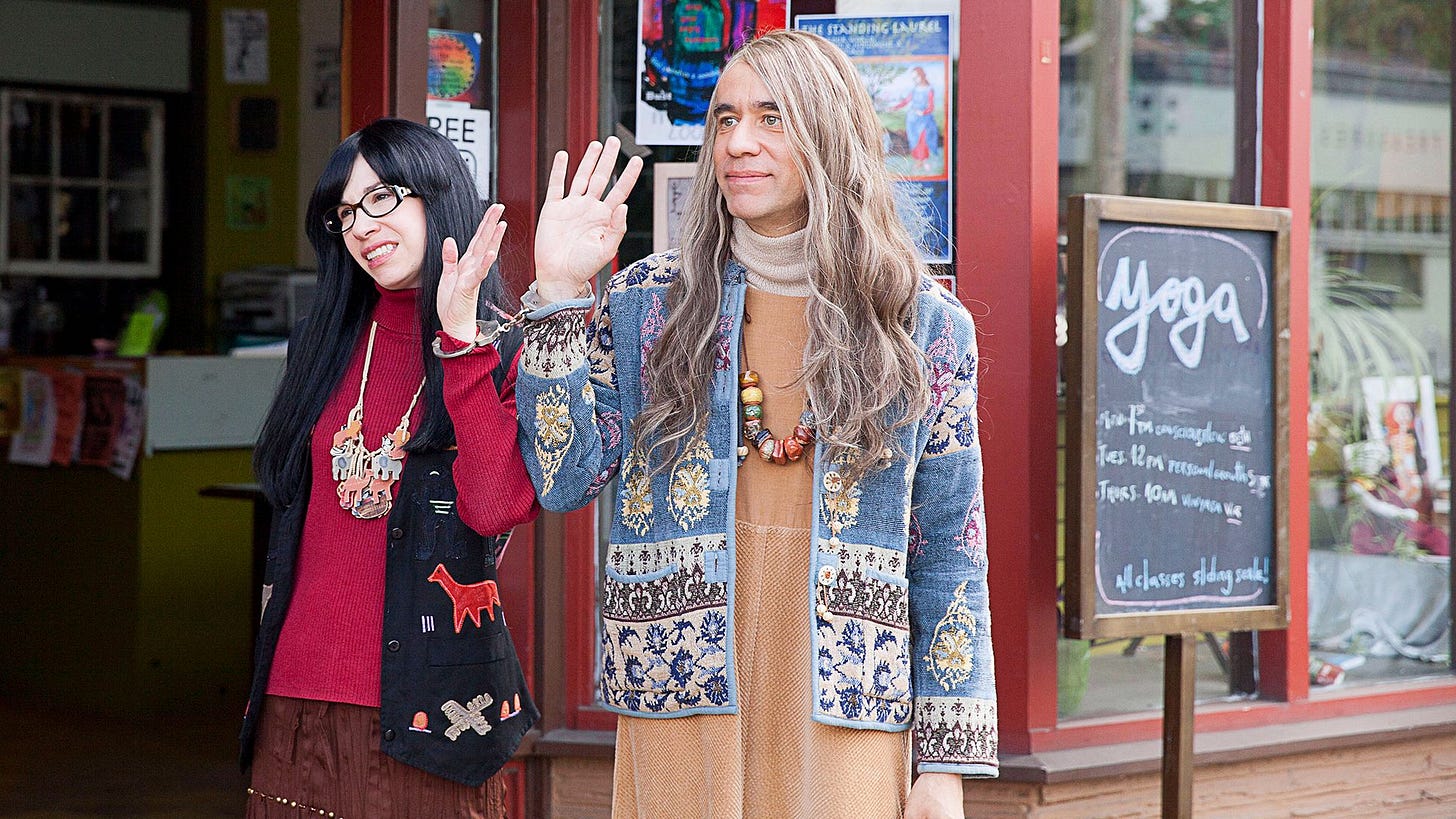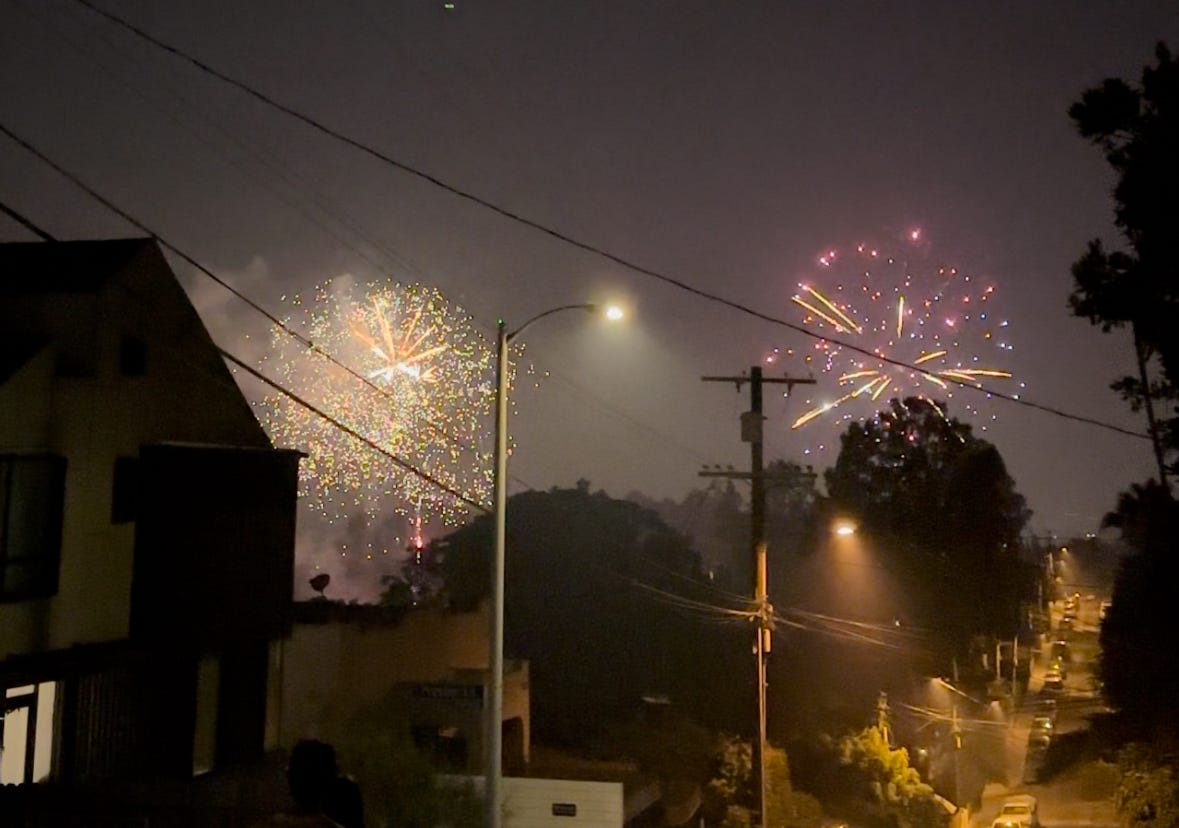Last week, I finally got around to watching Ingrid Goes West (2017), a comedy that follows Instagram influencer Taylor Sloane and her overly attached follower Ingrid Thorburn. Fresh off losing her mother and getting dispatched from a mental institution, Thorburn (played by Aubrey Plaza) moves to sunny Los Angeles for a fresh start - and to get closer to Sloane (played by Elizabeth Olsen), her latest social media obsession.
Upon her arrival, Thorburn traces Sloane’s every step; she eats at the restaurants Sloane posts about, purchases the same clothes as her, and even goes blonde and adopts a vocal fry. Through a series of calculated events - including kidnapping, “finding,” and returning Sloane’s dog - Thorburn becomes close friends with Sloane, earning a grid post for her hundreds of thousands of followers and developing a small following of her own. This friendship, built on lies, becomes increasingly unstable as Thorburn struggles to hold all the threads together, and as Sloane loses interest, their friendship as much of a trend to her as the mohair cardigan on her back and the Navajo rug in her living room.
I couldn’t have picked a more fitting movie to watch before spending a long Fourth of July weekend in Los Angeles myself. Beyond its satirical portrayal of social media performance and parasociality, Ingrid Goes West bottles the tone and feeling of 2010s LA exquisitely. Growing up in the western Washington suburbs, periodically venturing across the lake to Seattle in high school was my first real foray into “culture.” However, Los Angeles, approximately a thousand miles south of me on the West Coast, became an object of intense fascination. In the early 2010s, I watched the Kardashians frolick around Calabasas and my favorite YouTubers migrate to West Hollywood, vicariously living through their Alfred Coffee runs, their Lemonade brunches, and their hikes through Runyon Canyon.
My boyfriend lived in West LA for two and a half years while I attended college in Seattle, and my visits down to see him were like something out of a movie, or a TV show, or a YouTube video. It was the first city I thoroughly experienced, at length, as a burgeoning adult, popping into art galleries, overdressing to avoid getting carded at wine bars, and driving through Bel Air just to gawk at the houses.
LA quickly became a home away from home. Continuous strings of sunny days were an antidote to the dreariness of the Pacific Northwest. Up north, I was a student, wiping her nose on her sleeve, eyes darting between her computer screen and the grey clouds rapping her window. I was a girl constantly getting caught in the rain, in all senses. Down south was an endless summer vacation.
Ingrid Goes West perfectly illustrates the feeling of perpetual sunshine on your skin, which is as intoxicating as it is unnatural. It’s the feeling of a rollercoaster climbing up and up with no signs of a drop; an elevator to the top for Sisyphus and his boulder. Los Angeles feels like a kind of cheat code - I constantly found myself wondering what the catch was.
The sunshine isn’t just literal. LA culture is underscored by a kind of uncanny chillness and optimism. In Ingrid Goes West, Taylor Sloane and her husband, Ezra, embody this luminous outlook to a tee; life is all avocado toast, designer launch parties, and drives out to Joshua Tree. This optimism is also reflected in their clothing: lemon yellow frocks, chevron-patterned blouses, sunglasses, and wide-brimmed straw hats. Wide smiles with countless rows of white teeth.
This sunniness feels distinctly LA, but also distinctly of an Obama-era America, at least in retrospect. In the 2010s, spotlights shone on cheery neighborhoods like West Hollywood, but also cities like Portland, Oregon, which occupied a more alternative, quirky kind of positivity. Bright red lipstick and Peter Pan collars, owl pendant necklaces, folk-stomp music, curly mustaches - all images that transport you back to a simpler, seemingly faraway time. A more culturally homogenous period, when our social media feeds were purely chronological. I was on the cusp of political consciousness in 2010, so it’s easy for me to assume that young people were less disillusioned by electoral politics than they are now. There was perhaps still hope that we could elect leaders with consciences, or at least leaders who didn’t bend the truth so shamelessly. Everything is easy to surmise in retrospect.
July 4, 2025, was the first Independence Day in Trump’s second administration and was the least spirited Fourth of July in my recent memory. The holiday arrived on the foothills of American tragedy and instability, much of which was localized to Los Angeles. At the start of this year, fires ravaged the LA area, burning tens of thousands of acres and homes, leaving many long-time residents with nothing. The ACLU estimates that recent LA ICE raids have led to the disappearance of over 1,500 people, and counting. All of this quickly preceded Trump’s executive decision to bomb Iran’s nuclear facilities, and amid his ongoing rollback of protections for transgender Americans. The country is riddled with fear and paranoia, to put it lightly.
As our plane landed in Hollywood Burbank airport, still joking about the characters in Ingrid Goes West, my boyfriend and I quipped that the theme of this Fourth of July weekend had to be Obama-era optimism. Not celebrating the administration, but the air of delusional optimism that typified it. All we needed was a straw hat with a feather in it, a crocheted crop top, and cut-off denim shorts. As soon as we got in the car, we put on Calvin Harris’ Funk Wav Bounces, Vol. 1 - slightly past the era in question, but quite in the spirit. Our unofficial thesis: does LA retain its cracked 2010s optimism, or is that a relic of a bygone era?
Our weekend kicked off with breakfast at All Time in Los Feliz (no celebrities spotted), followed by a long walk to the Sunset Junction in Silver Lake for coffee. Los Angeles is famously a city unfriendly to walkers, but my boyfriend and I have always been determined to push the boundaries of that assumption. If you’re willing to brave the noisiness of four-lane roads and the lack of shade on sprawling boulevards, you can walk just about anywhere.
As we settled on an empty stretch of beach with friends in Venice, our relaxation was interrupted by cops coasting by on ATVs, swerving around the towels and umbrellas, shooting piercing glares at innocuous beachgoers lying on their stomachs. Our conversation dropped, and the muscles in our bodies tensed, as the officers drove laps around the beach without any discernible goal outside of, frankly, intimidation. Once the ATVs moved on, our peace was interrupted once more by the sirens of a cop car, which blared as the vehicle sped down the sand. After about two hundred yards of blaring and speeding, the car slowed, and the alarms paused, having completed its mission. We see you, we know you see us.
During anti-ICE protests in June, Trump sent over 4,000 National Guard troops and 700 Marines to LA “to protect federal property and employees.” A few weeks later, the city still feels waterlogged with cops. Law enforcement was unavoidable everywhere we went, but was rarely seen doing anything of use. If they weren’t doing donuts on the beach, they were in the grocery aisle as we shopped for ingredients for a barbecue, fully suited, debating what hot sauce to get. They were boxing us into a parking spot on the street, forcing us to make a fifteen-point maneuver to get out. There they were on neighborhood streets, making circles on their motorcycles, a version of thumb-twiddling.
The presence of law enforcement was even felt in its absence. Across the eastside, flyers for missing persons abducted by ICE were taped to lampposts and store facades. A sharp contrast to the sceney cafes and bakeries - shiny emblems of the world in Ingrid Goes West - were posters reading “MISSING MOTHER,” “MISSING SON,” and “MISSING GRANDMOTHER” in bold red font. “Lived in the US for 33 years after arriving at age 12. Fled the ravages of the Vietnam war and entered US legally,” accompanied by a photo of a smiling woman and her family, a child sitting on her lap.
As fireworks cracked overhead and cobs of corn sizzled on the grill, it was hard to remember what exactly was worth preserving, let alone celebrating. Houses have burned, families have been torn apart, and an administration and its supporters have looked on with cold apathy. If there was any faith in electoral politics in summer sixteen, it’s surely been zapped up now.
Ingrid Goes West reaches its climax when Sloane finally confronts Thorburn about her stalker tendencies. In response, Thorburn holds up a mirror, calling out Sloane’s vapid performance online; neither of them is what they say they are. Alone and in distress, Thorburn attempts suicide after posting a video to her IG grid about wanting to end it all. The next day, she wakes in a hospital bed to thousands of followers, all of them urging her to “keep going” and dubbing her an inspiration for baring her soul online. A grin grows across her face; she’s done it. After years of following (in all regards), she is the one who finally gets to be followed.
This ending sums up what many deduce about Los Angeles, at least from mainstream media. It’s what I had once deduced after many years of visiting. That it’s a city for the most stale and conceited of dreams; where people sweat harder for fame than they do for fortune. That the white-hot sun and absence of shade overexpose you, as do the monotonous desert roads, the horizon stretching further and further out, the whole region like a trick deck of cards. It’s, of course, hyperbole.
Nothing, unfortunately, alerts you to shared humanity quite as abruptly as shared tragedy. And even then. In Los Angeles, glimmers of old delusions remain, as do glimmers of old optimism. It’s accompanied by rage, but it’s there, in the mutual aid efforts that sprang out of the wildfires, the funds continuing to be raised for families to rebuild their lives. In the tens of thousands of protestors assembling against ICE and against oligarchy. In Notes of a Native Son (1955), James Baldwin writes: “I love America more than any other country in the world and, exactly for this reason, I insist on the right to criticize her perpetually." In Los Angeles, in the rubble, everywhere, there is still an idea - a real people, a home - worth preserving.
Cafe Hysteria was lucky enough to be featured in The Substack Post last month (!), which brought in a handful of new paid subscribers. In honor of that, I’m donating money made from paid subs in July to the Coalition for Humane Immigration Rights (CHIRLA), an LA-based nonprofit providing immigrants with legal assistance and educational services. If you’re looking to contribute, consider these California-based immigration rights orgs, or these families and small businesses rebuilding after the LA fires.









I love your last paragraph -- it's emblematic of the very optimism you're writing about, and an optimism that I feel will be so essential in the coming years as we try to address increasingly dire problems!
This movie is going on my to-watch list immediately. (Aww the owl necklaces and peterpan collars brought back memories! )